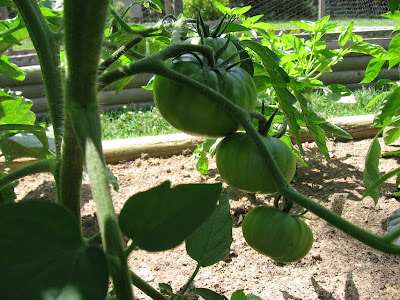The hot weather plants, tomatoes, peppers, eggplant and squash are all growing vigourously too. Only the okra, a new variety for me called Red Burgundy, is growing slowly. The first summer squash – cocozelle – is just about ready, the earliest ever.
It takes a little time to get the posts set up with the
right spacing and the cages aligned and set into the post hooks but once in place
they are good for the season. The posts
can be hard to pull out in the fall. If
they don’t come out I add some water at the base and wait a few hours.
In addition to building support for indeterminate tomatoes I
always sucker them as we say in the midwest (other people may prune them). Some growers remove
all suckers and train to the central leader.
In my view that’s fine if you’ve got a cage about sixteen feet high. Some growers don’t remove any suckers. I’ve found that can leave too much foliage
which can lower yields and promote diseases due to poor air circulation. Kitsap has a good discussion of suckering
tomatoes here if you want additional info: http://www.modernvictorygarden.com/apps/blog/show/15538426-harvest-monday-and-tomato-pruning-
I try to leave three or four suckers to start with. Once the plants are about four to five feet high they are usually growing so vigourously that it’s hard to keep up with the suckers and I don’t try. The early suckers are like the major branches of a large tree, the later suckers are like small branches. Here’s the Supersonic plant right after it was suckered:
This plant early in its life put a lot of energy into one
sucker, so that the sucker is the equal of the main stem. The sucker goes to the left and the main stem
goes to the right. I decided to just go
with that, like a tree that has two equal forks, and remove all the suckers
below the fork. You can see in the
picture that the lower suckers have been cut off. The lower leaves will eventually die off and
leave the lower parts well ventilated.
The Black Krim plant is growing exactly the same way, with
most of it’s energy going into one sucker (on the left) and the main stem. I used the same approach on this plant
too. A bifurcated plant should fill out
the cage nicely. The Black Krim has
already set some nice tomatoes. It was
recommended to me by a vendor at the Bloomington farmers market.
Both tomato plants were transplanted into the beds on May 1,
which is very early for this area. My
strategy is to get them out as soon as it looks like the weather will
allow. This spring was the warmest on
record and the soil had already warmed above 60 degrees. The last days of April had some frosts so I
held off until the ten day forecast (I like Intellicast) on May 1 showed no
lows below 40 degrees. A low in the
upper 30’s won’t kill a tomato plant but it may stunt it. Eggplants especially do not like that kind of
weather, they will stop growing and never resume growth (in my experience
anyway). Getting the tomatoes in the
beds ASAP means that I’ve got some tomatoes on the vine that are progressing
well in early June.
I tried a different strategy with squash this year. I seeded the squash April 17 in five inch
plastic drinking cups with holes punched in the bottom. Squash have large seeds that can send roots
down very fast and they cannnot be kept in a container very long. By May 1 it was past time to get them in the
beds. When I set the squash seedlings
into the beds I planted some seeds of the same variety around each seedling, as
a backup.
It turns out that the butternut did not tolerate a few nights
in the low 40’s, while the squash that was direct seeded did
fine. After a few weeks a butternut that
was direct seeded was looking better than the transplant, which had small
leaves, short stems, little growth - stunted. So I
pulled up the original transplant and gave the space to the younger butternut. Having some insurance pays off.






4 comments:
Your tomatoes are going to be awesome!!! I can't wait to see them in the coming Harvest Mondays!
Great info. Thanks! That is a great looking squash AND squash blossom..yummy.
I really like your caging system. It looks very sturdy and workmanlike. I think you and I actually end up with much the same result on pruning (suckering) as our methods are not too much different really.
Your tomato plants have really good sturdy central stems and those fruiting plants bear evidence to your good care and choices in timing the plantings.
wow your green tomatoes look huge. My Italian Heirloom and Amish Paste are just beginning to set, but I wasn't able to start them until March 1; usually I start all the tomatoes and peppers in Jan & Feb. Your squash and broccoli are lovely; I think most of us had a very early spring this year!
Post a Comment